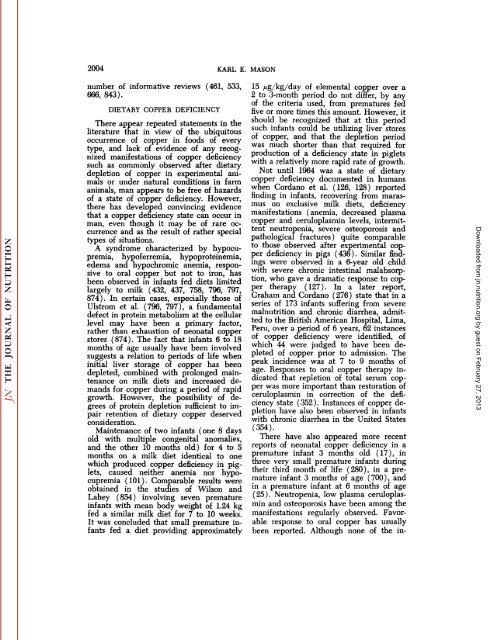conspectus of researchon copper metabolism and requirements
conspectus of researchon copper metabolism and requirements
conspectus of researchon copper metabolism and requirements
You also want an ePaper? Increase the reach of your titles
YUMPU automatically turns print PDFs into web optimized ePapers that Google loves.
2004 KARL E. MASON<br />
number <strong>of</strong> informative reviews (461, 533,<br />
666, 843).<br />
DIETARY COPPER DEFICIENCY<br />
There appear repeated statements in the<br />
literature that in view <strong>of</strong> the ubiquitous<br />
occurrence <strong>of</strong> <strong>copper</strong> in foods <strong>of</strong> every<br />
type, <strong>and</strong> lack <strong>of</strong> evidence <strong>of</strong> any recog<br />
nized manifestations <strong>of</strong> <strong>copper</strong> deficiency<br />
such as commonly observed after dietary<br />
depletion <strong>of</strong> <strong>copper</strong> in experimental ani<br />
mals or under natural conditions in farm<br />
animals, man appears to be free <strong>of</strong> hazards<br />
<strong>of</strong> a state <strong>of</strong> <strong>copper</strong> deficiency. However,<br />
there has developed convincing evidence<br />
that a <strong>copper</strong> deficiency state can occur in<br />
man, even though it may be <strong>of</strong> rare oc<br />
currence <strong>and</strong> as the result <strong>of</strong> rather special<br />
types <strong>of</strong> situations.<br />
A syndrome characterized by hypocupremia,<br />
hyp<strong>of</strong>erremia, hypoproteinemia,<br />
edema <strong>and</strong> hypochromic anemia, respon<br />
sive to oral <strong>copper</strong> but not to iron, has<br />
been observed in infants fed diets limited<br />
largely to milk (432, 437, 758, 796, 797,<br />
874). In certain cases, especially those <strong>of</strong><br />
Ulstrom et al. (796, 797), a fundamental<br />
defect in protein <strong>metabolism</strong> at the cellular<br />
level may have been a primary factor,<br />
rather than exhaustion <strong>of</strong> neonatal <strong>copper</strong><br />
stores (874). The fact that infants 6 to 18<br />
months <strong>of</strong> age usually have been involved<br />
suggests a relation to periods <strong>of</strong> life when<br />
initial liver storage <strong>of</strong> <strong>copper</strong> has been<br />
depleted, combined with prolonged main<br />
tenance on milk diets <strong>and</strong> increased de<br />
m<strong>and</strong>s for <strong>copper</strong> during a period <strong>of</strong> rapid<br />
growth. However, the possibility <strong>of</strong> de<br />
grees <strong>of</strong> protein depletion sufficient to im<br />
pair retention <strong>of</strong> dietary <strong>copper</strong> deserved<br />
consideration.<br />
Maintenance <strong>of</strong> two infants (one 8 days<br />
old with multiple congenital anomalies,<br />
<strong>and</strong> the other 10 months old) for 4 to 5<br />
months on a milk diet identical to one<br />
which produced <strong>copper</strong> deficiency in pig<br />
lets, caused neither anemia nor hypocupremia<br />
(101). Comparable results were<br />
obtained in the studies <strong>of</strong> Wilson <strong>and</strong><br />
Lahey (854) involving seven premature<br />
infants with mean body weight <strong>of</strong> 1.24 kg<br />
fed a similar milk diet for 7 to 10 weeks.<br />
It was concluded that small premature in<br />
fants fed a diet providing approximately<br />
15 /xg/kg/day <strong>of</strong> elemental <strong>copper</strong> over a<br />
2 to 3-month period do not differ, by any<br />
<strong>of</strong> the criteria used, from prematures fed<br />
five or more times this amount. However, it<br />
should be recognized that at this period<br />
such infants could be utilizing liver stores<br />
<strong>of</strong> <strong>copper</strong>, <strong>and</strong> that the depletion period<br />
was much shorter than that required for<br />
production <strong>of</strong> a deficiency state in piglets<br />
with a relatively more rapid rate <strong>of</strong> growth.<br />
Not until 1964 was a state <strong>of</strong> dietary<br />
<strong>copper</strong> deficiency documented in humans<br />
when Cordano et al. (126, 128) reported<br />
finding in infants, recovering from maras<br />
mus on exclusive milk diets, deficiency<br />
manifestations (anemia, decreased plasma<br />
<strong>copper</strong> <strong>and</strong> ceruloplasmin levels, intermit<br />
tent neutropenia, severe osteoporosis <strong>and</strong><br />
pathological fractures) quite comparable<br />
to those observed after experimental cop<br />
per deficiency in pigs (436). Similar find<br />
ings were observed in a 6-year old child<br />
with severe chronic intestinal malabsorption,<br />
who gave a dramatic response to cop<br />
per therapy (127). In a later report,<br />
Graham <strong>and</strong> Cordano (276) state that in a<br />
series <strong>of</strong> 173 infants suffering from severe<br />
malnutrition <strong>and</strong> chronic diarrhea, admit<br />
ted to the British American Hospital, Lima,<br />
Peru, over a period <strong>of</strong> 6 years, 62 instances<br />
<strong>of</strong> <strong>copper</strong> deficiency were identified, <strong>of</strong><br />
which 44 were judged to have been de<br />
pleted <strong>of</strong> <strong>copper</strong> prior to admission. The<br />
peak incidence was at 7 to 9 months <strong>of</strong><br />
age. Responses to oral <strong>copper</strong> therapy in<br />
dicated that repletion <strong>of</strong> total serum cop<br />
per was more important than restoration <strong>of</strong><br />
ceruloplasmin in correction <strong>of</strong> the defi<br />
ciency state (352). Instances <strong>of</strong> <strong>copper</strong> de<br />
pletion have also been observed in infants<br />
with chronic diarrhea in the United States<br />
(354).<br />
There have also appeared more recent<br />
reports <strong>of</strong> neonatal <strong>copper</strong> deficiency in a<br />
premature infant 3 months old (17), in<br />
three very small premature infants during<br />
their third month <strong>of</strong> life (280), in a pre<br />
mature infant 3 months <strong>of</strong> age (700), <strong>and</strong><br />
in a premature infant at 6 months <strong>of</strong> age<br />
(25). Neutropenia, low plasma ceruloplas<br />
min <strong>and</strong> osteoporosis have been among the<br />
manifestations regularly observed. Favor<br />
able response to oral <strong>copper</strong> has usually<br />
been reported. Although none <strong>of</strong> the in-<br />
Downloaded from<br />
jn.nutrition.org<br />
by guest on February 27, 2013
















